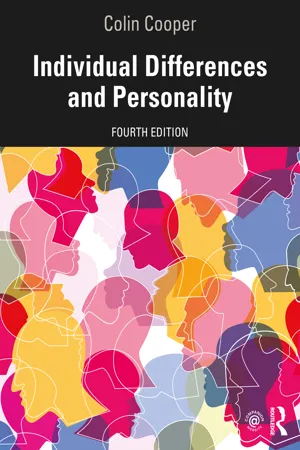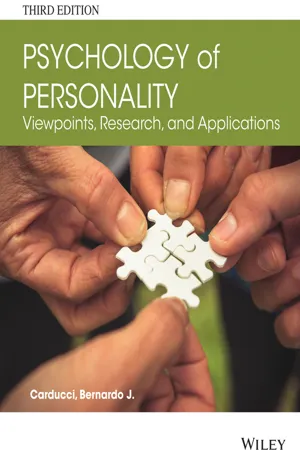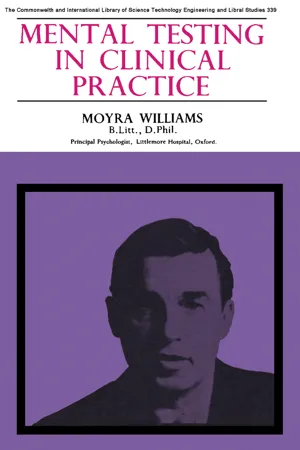Psychology
Measuring Personality
Measuring personality involves assessing an individual's characteristic patterns of thoughts, feelings, and behaviors. Psychologists use various methods, such as self-report questionnaires, behavioral observations, and projective tests, to measure personality traits and dimensions. These assessments help in understanding an individual's unique psychological makeup and predicting their behavior in different situations.
Written by Perlego with AI-assistance
Related key terms
1 of 5
12 Key excerpts on "Measuring Personality"
- eBook - PDF
- John Hunsley, Catherine M. Lee(Authors)
- 2017(Publication Date)
- Wiley(Publisher)
Over the past century, psychologists have constructed literally thousands of measures of individual differences. Many of these mea- sures are designed to assess personality traits, which psychologists define as consistencies in behaviour, emotions, and attitudes that are evident across situations and across time. Personality theorists and researchers work to examine the influences of genetics and life experi- ences on the development of traits (Mischel, 2004) and how traits are expressed in everyday life (Hampson, 2012). Clinical psychologists are active in both researching personality traits and in assessing person- ality traits for clinical purposes. As you may know from taking a Assessment: Self-Report and Projective Measures Introduction The Person-Situation Debate Self-Presentation Biases Developing Culturally Appropriate Measures The Clinical Utility of Self-Report and Projective Measures Self-Report Personality Measures MMPI-2 and MMPI-A Other Clinical Measures of Personality Functioning Self-Report Checklists of Behaviours and Symptoms Achenbach System of Empirically Based Assessment SCL-90-R Outcome Questionnaire 45 Beck Depression Inventory-II Children’s Depression Inventory 2 Projective Measures of Personality Rorschach Inkblot Test Summary and Conclusions 170 CHAPTER 8 Assessment: Self-Report and Projective Measures personality theory course, personality measures vary in the scope of the constructs they are designed to assess. Some are intended to measure very broad constructs such as extraver- sion or neuroticism; others focus on highly specific constructs such as perfectionism or moti- vation for academic tasks. Most personality measures are based on self-report data and are often called objective personality tests because they can be scored objectively (i.e., the same scoring system is always used). - eBook - ePub
Personality
The Psychometric View
- Paul Kline(Author)
- 2013(Publication Date)
- Routledge(Publisher)
Chapter 2 Measurement of personality Personality tests Since the early days of psychology, there have been attempts to measure personality, with a variety of different kinds of tests. As a result of this considerable research effort, in the modern study of personality there are now three kinds of psychological test in general use: personality questionnaires or inventories (these terms are absolutely interchangeable); projective tests; and objective tests. Before describing these different types of personality tests, a few more general points about psychological measurement need to be made, thus enabling a fine examination of personality measurement. The characteristics of good psychological tests Psychometrics is the study of individual differences by means of psychological tests. Psychometricians, as specialists in measurement, attempt to produce tests with certain key features and these are set out below. They are the essentials of precise measurement and are thus critical for the proper application of the scientific method. All good tests should be highly reliable, valid, discriminating and have good norms. The meaning of these terms will now be discussed. To do this, however, a number of concepts require some explanation. Universe of items Any set of items in a test is assumed to be a random sample from a universe of relevant items. This universe is, of course, notional and infinite. The better the sample of items the better the test. The score on a psychological test is known as the obtained or the fallible score. This is to be distinguished from the true score. Any fallible score consists of true score + error. True score The true score consists of the score of a subject on the universe of items. This is, therefore, a notional score. However, as shall be seen, it can be estimated from the obtained or fallible score provided that the reliability of the test is known - eBook - PDF
Contemporary Themes in Strategic People Management
A Case-Based Approach
- David Hall, Stephen Pilbeam, Marjorie Corbridge(Authors)
- 2017(Publication Date)
- Red Globe Press(Publisher)
CHAPTER 8 Psychometric Assessment and Personality Questionnaires Survey results and case study findings Stephen Pilbeam, Louisa Allison and Stacey White Psychometrics is a term which encompasses all forms of psychological assessment – ‘psycho’ relates to the mind and ‘metric’ implies measurement, so ‘psychometric’ is the measurement of the mind – an ambitious task! In an occupational setting psychometric assessment consists of tests and questionnaires designed to measure individual differences. These psychometric ‘instruments’ are capable of being systematically scored and are supported by evidence and statistical data which seek to demonstrate their validity in contributing to deci-sions about suitability for particular types of work or specific positions within an organisation to achieve the strategic people management aim of having the right people in the right place at the right time, with the right abilities, competencies and motivation. Psychometric instruments seek to measure Attainment, General Intelligence, Cognitive Ability, Trainability and Personality. In the case of prop-erly validated attainment, general intelligence, cognitive ability and trainability tests, measurement outputs can be related to specific jobs and, appropriately chosen and used, there is little contention that they are able to provide useful information for selection decisions. The assessment of personality, the focus of this chapter, provides a more challenging arena because it aims to infer relatively enduring individual characteristics and traits as a basis for predicting behaviour at work. Personality ‘tests’ do not generate ‘right’ or ‘wrong’ answers; they are designed to present a profile of an individual. Arguably ‘testing’ is a misnomer because it implies that a personality test can be failed, and it is self-evident that every individual has a personality. - eBook - ePub
Personality and Disease
Scientific Proof vs. Wishful Thinking
- Christoffer Johansen(Author)
- 2018(Publication Date)
- Academic Press(Publisher)
When Measuring Personality we are, again according to Lazarus (1971), referring to a quantitative dimension in the same way as we consider intelligence to be a psychological trait. In clinical psychiatry we have the term personality disorders, which we describe qualitatively as types rather than traits. Feighner et al. (1972) introduced the typological use of algorithms in psychiatric research and used Antisocial Personality Disorder (ASPD) as an example. The ASPD was defined as a chronic disorder requiring a minimum of five out of nine manifestations to be definitely present. In diagnostic and statistical manual of mental disorders. Fifth edition (DSM-5) (American Psychiatric Association, 2013) personality disorders are still considered as being derived from categorical algorithms. However, in the DSM-5 the five-factor model (Costa & Widiger, 2001) is included as an alternative proposal. This five-factor model lists five personality traits or factors, namely (1) neuroticism, (2) extraversion, (3) openness, (4) agreeableness, and (5) conscientiousness. The DSM-5 decision to officially delete personality dimensions when describing personality disorders is based on the fact that we have no acceptable sharp cutoff between personality traits and personality disorders. Among the five personality traits identified by the five-factor model, the traits of neuroticism and extraversion are the most distinct and best studied as regards the measurement of personality dimensionality (Bech, 2016). The psychometric measurement of neuroticism and extraversion is therefore the focus of this chapter on how to measure personality. Psychometrics The emergence of psychometrics is ascribed to Wilhelm Wundt (1820–1920) who is regarded as the first experimental psychologist (Bech, 2012). He founded the psychological laboratory at the University of Leipzig in 1879 - eBook - PDF
- Robert Hogan, John Johnson, Stephen Briggs(Authors)
- 1997(Publication Date)
- Academic Press(Publisher)
Within the field of personality, there appears to be greater agreement concerning how concepts should be measured (e.g., Fiske, 1971) than on what CHAPTER 4 IN DEFENSE OF TRAITS 99 concepts should be measured (e.g., Levy, 1970). Thus, achievement of a working consensus on the nature of the trait concept would be a large first step toward a psychology of personality. Most previous discussions of the trait concept in psychology have focused on traits as attributes of persons. Thus, the first task of psychometrics has been consid-ered that of developing scales and inventories to measure the tendencies of persons to act in certain ways on certain occasions (e.g., Edwards, 1970). But this logically presupposes a clear conception of which particular actions are to be accounted for on what particular occasions. To say that a person is aggressive is to say that the person has behaved or is likely to behave aggressively on certain occasions. But what is an aggressive action? And how would we quantify the aggressiveness of an action? I intend to distinguish among statements expressing: quaUties ot actions (John pushed the boy aggressively), (2) properties of persons (John is aggressive), and (3) aspects of future occurrences (If frustrated, John is likely to behave aggres-sively). I will argue that the first statement conveys an institutional fact; the second, a categorical summary of the general trend of a person's conduct to date; and the third, a hypothetical proposition that is inferred, but not deduced, from statements of the second type. In the specialized terminology of the psychometric-trait approach to personality, these distinctions correspond roughly to those sometimes made among observation, assessment, and prediction. n. TRAITS AS ATTRIBUTES OF BEHAVIOR John pushed the boy describes an action or sequence of behavior. - eBook - ePub
- Colin Cooper(Author)
- 2020(Publication Date)
- Routledge(Publisher)
Chapter 3Measuring individual differences
Introduction
The previous chapter mentioned the use of a questionnaire to measure self-esteem, but it did not go into any detail about how questionnaires and tests are constructed, used and evaluated. If we are unable to actually measure people’s levels of self-esteem, anxiety, intelligence or other characteristics accurately, then the study of individual differences can never be scientific or quantitative; it will be difficult to test theories, or to assess these characteristics for the purpose of diagnosis, individual guidance or personnel selection. So before studying other theories it seems sensible to pause and to discuss how we can go about measuring individual differences; more detail about designing and using tests and questionnaires is given in Chapters 20 and 21 .This chapter thus provides an introduction to psychometrics, the branch of psychology that deals with the measurement of individual differences. It introduces the concepts of trait and state. Various types of psychological test are outlined and the interpretation of individual scores through the use of norms is discussed. Finally, some guidance is given as to how to select a test and use it ethically. - eBook - PDF
- Rocio Fernandez-Ballesteros(Author)
- 2002(Publication Date)
- SAGE Publications Ltd(Publisher)
FUTURE PERSPECTIVES Throughout much of its history, a great part of personality psychology has been concerned with individual differences in observable variations in styles of behaviour, affect, and cognition. The variations have been organized according to, and traced back to, simple systems of dispositional constructs. Trait constructs have been posited to account for stable patterns of experience and action that people exhibit, and that distinguish them from one another across times and situations. Within this line of thinking, person-ality has been conceptualized as a hierarchical organization with high-level traits (e.g. extrover-sion) that organize lower level tendencies (e.g. sociability) which, in turn, supervise lower level behavioural habits (e.g. talkative) (Eysenck, 1970). A key question here is to identify the number and nature of the high-level traits. In the past, alternative taxonomies competed. Today, a broad consensus has emerged. It centres on five global dispositional tendencies (the so called Big Five): Extroversion, Agreeableness, Conscien-tiousness, Emotional Stability, and Openness to experience. A variety of self-report and observer-report measures have been produced to assess the five dispositions as well as a variety of other traits that correspond to their different facets of each main trait or the result of their combina-tions from them and from their combinations. Among the most diffused instruments one finds the NEOPI-R of Costa and McCrae (1992) and Personality Assessment (General) 705 the BFQ of Caprara, Barbaranelli, Borgogni and Perugini (1993). This approach, however, meets only part of what personality assessment should aim to achieve. The Five Factor Model (FFM) offers a highly convenient lexicon to help subject–assessor communication. The clarity of the conceptualiza-tion of the five factors may increase raters’ reliability and reduce interrater variability across settings and times. - eBook - PDF
Psychology of Personality
Viewpoints, Research, and Applications
- Bernardo J. Carducci(Author)
- 2015(Publication Date)
- Wiley(Publisher)
objective self-report techniques Techniques of personal- ity assessment characterized by standardized adminis- tration and scoring procedures. personality assessment The systematic measurement of different aspects of personality. personality profile A summarized interpretation of a collection of personality characteristics in written and graphic form. positron emission tomography (PET) A computer image of brain activity based on the assessment of brain activity as indicated by the rate of usage of energy-producing substances by brain cells. predictive validity The ability of a test score to predict a criterion measure in the future. press An environmental factor that affects needs as mea- sured by the Thematic Apperception Test. profile analysis The identification of a specific personality pattern based on the scores of several dimensions of personality. projective techniques Techniques of personality assess- ment based on an interpretation of the subject’s responses to ambiguous stimuli. psychometricians Individuals who have specialized pro- fessional training in administering, scoring, and inter- preting the results of personality tests and other tech- niques of psychological assessment. reliability The assessment consistency of a personality test. reliability coefficient A numerical index of the consis- tency of a test score. response set Answering test questions in a biased man- ner. role playing The acting out of an assigned role for the pur- pose of assessing behavioral and emotional reactions. self-fulfilling prophecy A tendency of individuals to begin to behave in a manner consistent with a diagnos- tic label attributed to them, thus providing after-the-fact support of the label. self-monitoring A personality dimension expressing the tendency for an individual’s behavior to reflect situa- tional demands versus personal beliefs. Self-Monitoring Scale A personality test assessing indi- vidual differences in self-monitoring. - eBook - PDF
Mental Testing in Clinical Practice
The Commonwealth and International Library: Mental Health and Social Medicine Division
- Moyra Williams, Hugh L. Freeman(Authors)
- 2017(Publication Date)
- Pergamon(Publisher)
(There are some people who would question this point, and maintain that no trait can ever, in fact, be measured in quantified terms.) Disadvantages (1) Much clinical insight may be lost if the psychologist is not observing a person's reactions at all moments during the test. It is not just what a person does that is important clinically, but how he does it—his hesitations, doubts, self-criticisms. (2) The reliability of a subject's answers to a questionnaire de- pends on his insight, co-operation and seriousness of intention at the time of answering. Although his rapport may be excel- lent at the time he starts filling up a questionnaire there is no way of knowing whether he retained it throughout, or whether an adverse influence undermined his intention half-way through. (3) The results may be vitiated by a subject's desire to appear in a good light, and to give answers which he believes to be socially desirable. PERSONALITY 57 (4) The ratings on questionnaires are only valid for subjects cor- responding in all essential details to the community on which they are standardised. Questionnaires and inventories have been developed by three main techniques. (a) Analysis of personality from the common-sense point of view The Cornell Index, which was developed during the Second World War, consists of ten items to which the subject has to answer only Yes or No. Its chief use has been in the selection and screening of military personnel, but re-tests have indicated that scores may change after a time interval, even though a person's apparent mental state remains unaltered (Anastasi, 1954). BelVs Adjustment Inventory aims to measure adjustment in four spheres—home, health, social, and emotional. - Scott T. Meier(Author)
- 2013(Publication Date)
- The Guilford Press(Publisher)
Such observations are plentiful in the measurement and assessment literature: There are hundreds of psychological tests but no analysis in terms of basic explan- atory principles, with no methodology for producing that connection. Personality theories arise either within naturalistic study—as in psychotherapy—or in the construction of psychometric instruments. (Staats, 1988, p. 4) Not only is there a need for more reliable and valid personality tests, but improve- ments in the theoretical bases of these instruments and in the criteria against which they are validated are necessary. . . . Many of these techniques represent relatively crude attempts to measure characteristics of human behavior. . . . It is generally recognized, however, that none of the available methods of assessing per- sonality is completely satisfactory.The solution to the problem clearly lies in better research and development. (Aiken, 1989, p. 418) A History of Traits 29 Not only are new insights in short supply, but it is clear that not much thought of a theoretical nature has gone into the question [of psychological measurement]. Self-report personality research has had a strong emphasis on empiricism to the partial or total exclusion of theory. (Epstein, 1979, pp. 364, 377) It is not the case, however, that the history of psychological measurement and assessment is devoid of attempts at theory development. By the middle of the 20th century, for example, evidence of more widespread interest in the processes of psychological measurement began to appear.The first technical recommendations for measurement produced by the APA were published in the mid-1950s. Cronbach and Meehl (1955) and Campbell and Fiske (1959) published their classic works on construct validity. Lord and Novick produced a major description of the concepts of item response theory in a 1968 publication, and Cronbach, Gleser, Nanda, and Rajaratnam described generalizability theory in a 1972 book.- eBook - PDF
Introduction to Personality
Toward an Integrative Science of the Person
- Walter Mischel, Yuichi Shoda, Ozlem Ayduk(Authors)
- 2012(Publication Date)
- Wiley(Publisher)
C H A P T E R 2 DATA, METHODS, AND TOOLS WHY A SCIENCE OF PERSONALITY?: BEYOND HINDSIGHT UNDERSTANDING IN FOCUS 2.1 Gary W., The Text’s Case—Gary’s Self-Description THE RANGE OF PERSONALITY-RELEVANT MEASURES Interviews IN FOCUS 2.2 Early Personality Measurement Tests and Self-Reports Projective Measures Naturalistic Observation and Behavior Sampling Remote Behavior Sampling: Daily Life Experiences Physiological Functioning and Brain Imaging Laboratory Methods of Social Cognition CONCEPTUAL AND METHODOLOGICAL TOOLS Constructs and Operational Definitions An Example: Defining the Construct of Aggression ESTABLISHING RELATIONSHIPS AMONG OBSERVATIONS Correlation: What Goes with What? Interpreting Correlations RELIABILITY AND VALIDITY OF OBSERVATIONS AND MEASURES Reliability: Are the Measurements Consistent? Validity: What Is Being Measured? Content Validity / Criterion Validity / Construct Validity: Validity of the Construct Itself IN FOCUS 2.3 Sometimes Direct Self-Report Measures Work Best THE EXPERIMENTAL APPROACH Independent and Dependent Variables / Experimental and Control Groups / Double-Blind Designs ETHICS IN PERSONALITY RESEARCH SUMMARY / KEY TERMS WHY A SCIENCE OF PERSONALITY?: BEYOND HINDSIGHT UNDERSTANDING Much of our lives are spent trying to understand, after the fact, our own and others’ behavior. In the words of the Danish philosopher S¨ oren Kierkegaard, ‘‘Life is lived forwards, but understood backwards.’’ And, as the saying goes, hindsight is 20/20. Past events can be explained in many ways, and there is no sure way to determine which, if any, of the alternative explanations is the right one. 2.1 Describe and compare two basic approaches to understanding behavior and its causes. What are the advantages of a scientific approach to understanding? Furthermore, we see only through our own eyes, and are convinced we see the truth, without realizing how different other accounts of the same event can be when seen through different eyes. - eBook - PDF
The Chronic Crisis in Psychological Measurement and Assessment
A Historical Survey
- Scott T. Meier(Author)
- 2013(Publication Date)
- Academic Press(Publisher)
TRADITIONAL APPROACHES Traditional measurement devices such as the WAIS-R, Rorschach, and MMPI-2 continue to be widely used by psychologists to assist in selection decisions in education, mental health, medicine, business and industry, and the legal system. As many authors have noted (Buros, 1970; Gynther & Green, 1982; Hathaway, 1972; Jackson, 1992; R. P. Martin, 1988; K. R. Mur-phy 8c Davidshofer, 1988), few innovations introduced since the 1940s have been powerful enough to alter the use of traditional tests and procedures employed by psychological practitioners and researchers. Traditional tests share certain methods, concepts, and statistical assump-tions. In classical test theory, an observed test score is composed of true score and error. The true score usually represents a trait, a relatively endur-ing personal characteristic that influences behavior across settings. The goal of classical test theory is to maximize the true score component and minimize error. During test construction and evaluation, classical measure-ment approaches attempt to identify and minimize error through statistical methods. Typically, self-report items completed by many individuals are aggregated to produce an estimate intended to discriminate traits and in-dividuals from other traits and individuals. MEASUREMENT OF PERSONALITY AND TEMPERAMENT Act-Frequency Analysis A central problem in personality psychology has been the identification of important personality traits (e.g., Cattell, 1946a, 1957; Eysenck, 1947; D. Fiske, 1949; McCrae 8c Costa, 1985). Buss and Craik (1983; see also Angleit-ner 8c Demtroder, 1988) described a procedure they termed an act-fre-quency analysis. In contrast to factor analysis, which attempts to reduce and isolate traits by focusing on items that covary, an act-frequency analysis involves a series of studies to identify prototypic acts characteristic of trait categories.
Index pages curate the most relevant extracts from our library of academic textbooks. They’ve been created using an in-house natural language model (NLM), each adding context and meaning to key research topics.











